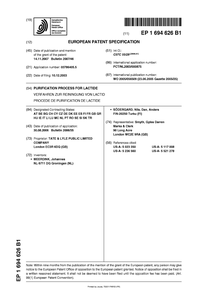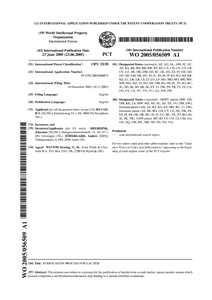The degradation of lactic acid under anoxic conditions was studied in several strains of Lactobacillus buchneri and in close relatives such as Lactobacillus parabuchneri, Lactobacillus kefir, and Lactobacillus hilgardii. Of these lactobacilli, L. buchneri and L. parabuchneri were able to degrade lactic acid under anoxic conditions, without requiring an external electron acceptor. Each mole of lactic acid was converted into approximately 0.5 mol of acetic acid, 0.5 mol of 1,2-propanediol, and traces of ethanol. Based on stoichiometry studies and the high levels of NAD-linked 1,2-propanediol-dependent oxidoreductase (530 to 790 nmol min−1 mg of protein−1), a novel pathway for anaerobic lactic acid degradation is proposed. The anaerobic degradation of lactic acid by L. buchneri does not support cell growth and is pH dependent. Acidic conditions are needed to induce the lactic-acid-degrading capacity of the cells and to maintain the lactic-acid-degrading activity. At a pH above 5.8 hardly any lactic acid degradation was observed. The exact function of anaerobic lactic acid degradation by L. buchneri is not certain, but some results indicate that it plays a role in maintaining cell viability.
DOCUMENT
The invention relates to an improved process for the purification of lactide from a crude lactide vapour product comprising at least lactide, lactic acid, water and linear lactic acid oligomers.
DOCUMENT

This study aimed to evaluate technological (acidification, proteolysis, lipolysis, resistance to low pH, NaCl, and bile salts) and biopreservation (antimicrobial activity against foodborne pathogens) features of 1002 LAB by high throughput screening (HTS) methods. The LAB was isolated from 11 types of Brazilian artisanal cheeses (BAC) marketed in the main 5 producing regions. Remarkable intra-species variability in acidification rates have been found, which was most pronounced between isolates from Mina's artisanal cheeses, Caipira and Coalho cheeses. Lacticaseibacillus paracasei and Levilactobacillus brevis showed the fastest acidification rate; however, all isolates showed slower acidification rates than a lactococcal control strain (4.3 × lower). When testing inhibitory effects, > 75% of LAB isolates could inhibit the growth of Staphylococcus aureus ATCC 19095 and Listeria monocytogenes ATCC 7644. Two of these isolates, identified as Lactiplantibacillus plantarum and Lentilactobacillus buchneri, the sterile and neutral supernatants alone, were sufficient to inhibit L. monocytogenes growth. Principal component analysis (PCA) allowed the identification of functional groups based on proteolytic and lipolytic activity, osmotic stress resistance, and inhibition of L. monocytogenes. The type of cheese the isolates were recovered from influenced properties such as anti-listerial compounds and lipolytic enzyme production. The use of HTS and multivariate statistics allowed insights into a diverse set of LAB technological and biopreservation properties. These findings allow a profound knowledge of the heterogeneity of a large set of isolates, which can be further used to design starter cultures with varied and combined properties, such as biopreservation and technological features. Besides that, HTS makes it possible to analyze a vast panel of LAB strains, reducing costs and time within laboratory analysis, while avoiding the loss of information once all LAB are tested at the same time (differently from the traditional labor-intensive approach, in which a few numbers of strains is tested per time).
DOCUMENT
The inventation relates to a process for the purification of lactide from a crude lactide vapour product stream which process comprises a rectification/condensation step to a lactide-enriched condensate.
DOCUMENT

Inoculation of maize silage with Lactobacillus buchneri (5 × 105 c.f.u. g-1 of maize silage) prior to ensiling results in the formation of aerobically stable silage. After 9 months, lactic acid bacterium counts are approximately 1010 c.f.u. g-1 in these treated silages. An important subpopulation (5.9 × 107 c.f.u. g-1) is able to degrade 1,2-propanediol, a fermentation product of L. buchneri, under anoxic conditions to 1-propanol and propionic acid. From this group of 1,2-propanediol-fermenting, facultatively anaerobic, heterofermentative lactobacilli, two rod-shaped isolates were purified and characterized. Comparative 16S rDNA sequence analysis revealed that the newly isolated bacteria have identical 16S rDNA sequences and belong phylogenetically to the L. buchneri group. DNA-DNA hybridizations, whole-cell protein fingerprinting and examination of phenotypic properties indicated that these two isolates represent a novel species, for which the name Lactobacillus diolivorans sp. nov. is proposed. The type strain is LMG 19667T ( = DSM 14421T).
DOCUMENT
Background: Acne vulgaris is a multifaceted skin disorder, affecting more than 85% of young individuals worldwide. Pharmacological therapy is not always desirable because of the development of antibiotic resistance or the potential risk of adverse effects. Non‐pharmacological therapies can be viable alternatives for conventional therapies. However, sufficient evidence‐based support in the efficacy and safety of non‐pharmacological therapies is lacking. Objective: To assess the efficacy and safety of several non‐pharmacological therapies in the treatment of acne vulgaris. Methods: A systematic literature review, including a best‐evidence synthesis, was performed to identify literature. Three electronic databases were accessed and searched for studies published between January 2000 and May 2017. Results: Thirty‐three eligible studies were included in our systematic review. Three main types of non‐pharmacological therapies were identified laser‐ and light‐based therapies, chemical peels and fractional microneedling radiofrequency. The majority of the included studies demonstrated a significant reduction in acne lesions. However, only seven studies had a high methodologic quality. Based on these seven trials, a best‐evidence synthesis was conducted. Strong evidence was found for glycolic acid (10–40%). Moderate evidence was found for amino fruit acid (20–60%), intense pulsed light (400–700 and 870–1200 nm) and the diode laser (1450 nm). Initially, conflicting evidence was found for pulsed dye laser (585–595 nm). The most frequently reported side‐effects for non‐pharmacological therapies included erythema, tolerable pain, purpura, oedema and a few cases of hyperpigmentation, which were in most cases mild and transient. Conclusion: Circumstantial evidence was found for non‐pharmacological therapies in the treatment of acne vulgaris. However, the lack of high methodological quality among included studies prevented us to draw clear conclusions, regarding a stepwise approach. Nevertheless, our systematic review including a best‐evidence synthesis did create order and structure in resulting outcomes in which a first step towards future research is generated.
DOCUMENT

A bacterium belonging to the Bacillus firmus/lentus-complex and capable of growth on native potato starch was isolated from sludge of a pilot plant unit for potato-starch production. Utilization of a crude enzyme preparation obtained from the culture fluid after growth of the microorganism on native starch, resulted in complete degradation of native starch granules from potato, maize and wheat at a temperature of 37°C. Glucose was found as a major product. Production of maltose, maltotriose and maltotetraose was also observed. Native-starch-degrading activity (NSDA) could be selectively adsorbed on potato-starch granules, whereas soluble-starch-degrading activity (SSDA) remained mainly in solution. The use of such a starch-adsorbed enzyme preparation on native starch resulted in a completely changed product pattern. An increase in oligosaccharides concomitant with less glucose formation was observed. An increased conversion of soluble starch to maltopentaose was possible with this starch-adsorbed enzyme preparation. It is concluded that NSDA comes from α-amylase(s) and SSDA from glucoamylase(s) and/or α-glucosidase(s). Cultivation of B. firmus/lentus on glucose, maltose, or soluble starch resulted in substantially smaller quantities of (native) starch-degrading activity.
LINK
Natural Deep Eutectic Solvents (NADES) represent a green chemistry alternative to utilization of common hazardous organic solvents. They were introduced by Abbott et al. [1], and were found to have a wide range of compositions and favorable properties. NADES are typically obtained by mixing hydrogen-bond acceptors (HBA), with hydrogen bond donors (HBD), leading to a significant depression of the melting point. The availability of components, simple preparation, biodegradability, safety, re usability and low cost are the significant advantages that call for research on their analytical applications. Three methods are most commonly used for preparing NADES: a) heating and stirring: the mixture until a clear liquid is formed; b) evaporating solvent from components solution with a rotatory evaporator; c) freeze drying of aqueous solutions.The common solvents for the extraction of anthocyanins are acidified mixtures of water with ethanol, methanol, or acetone. The anthocyanins extracts are susceptible to degradation due to high temperature, and the solvent properties (e.g. high pH) and the whole process can often be time-consuming. Extraction of anthocyanins from red cabbage by four NADES was investigated. It was demonstrated that NADES have comparable extraction efficiencies with conventional method with 0.1 M water solution of HCl. This indicates a possibility of utilization the Green chemistry extraction processes as a promising new green-extraction technology with low cost efficiency and environment friendly technology for production of safe food additives.
DOCUMENT

Docentonderzoeker Rob van Diepenbeek was een van de sprekers op de Intelligent Food processing & packaging Virtual Summit, een online platform waar foodprofessionals kunnen netwerken, ideeën en kennis uitwisselen en van elkaar leren waar het gaat om toekomst van ons voedsel. Rob ging onder meer in op de nauwe samenwerking van HAS Hogeschool met Food Tech Brainport in Helmond, een belangrijke experimenteerruimte als het gaat om het terugdringen van voedselverspilling en bij- en reststromen te verwaarden door middel van milde conservering en milde scheidingstechnieken. Veelbelovende productapplicatie-kansen en energiebesparingen kwamen aan bod.
DOCUMENT
